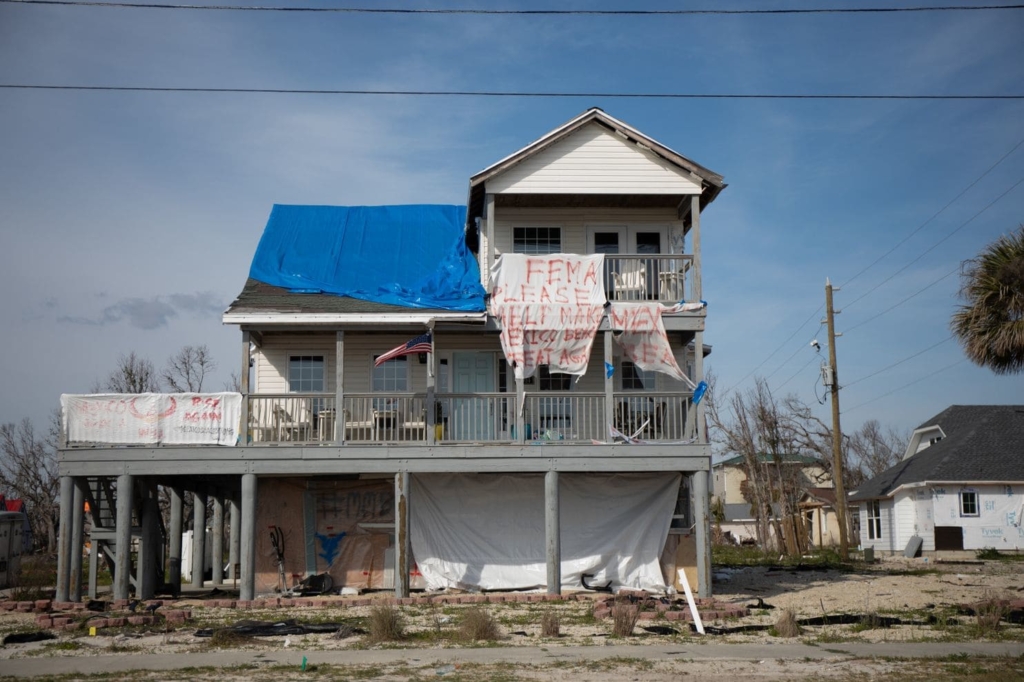Survivors of Hurricane Michael in the Florida Panhandle fear they have been forgotten
By Patricia Sullivan and Joel Achenbach
6 April 2019
MEXICO BEACH, Florida (The Washington Post) – The towering debris piles that lined Highway 98 are gone now, six months after the 16-foot storm surge from Hurricane Michael pulverized this town. But smaller berms of waste remain: concrete blocks, rebar, pipes and planks, mounded like artificial dunes on the side of the road.
The landscape is still scraped to bare sand and dirt, denuded of trees and plants. The few longtime residents who remain talk about losing their way because they have no landmarks. The occasional tourist passes through, astonished by the lingering destruction from the storm, which made landfall on Oct. 10, with wind speeds of up to 155 mph.
“You kind of want to believe it’s all okay now,” said Priscilla Moore, 51, of Powder Springs, Ga., who has vacationed here for 47 years. “But oh my goodness, it’s gone, it’s just all gone.”

The stretch of the Florida Panhandle east of Panama City is known as the Forgotten Coast, because it’s so rural and undeveloped — a remnant of a wild, pre-Disney, pre-air-conditioned Florida. That moniker has become more searing in the aftermath of the fourth-strongest hurricane, as measured by wind speed, ever to hit the mainland United States.
Government agencies have cleared the roads and utilities have restored power, water and communications, but thousands of people are still desperate for permanent housing, competing not only with one another for the scarce supply of rental units, but with construction workers who have come into the area.
Many residents are living in damaged homes or trailers unfit for human habitation. Some live in tents. Homeowners are frustrated by stingy insurance companies and bewildering government paperwork, and they’re wary of shady contractors. […]
In inland Marianna (population 6,000), the federal prison with its 500-person payroll is all but closed, its inmates and employees moved to other federal facilities. The state’s institution for the developmentally delayed, which serves 250 clients, is just getting its debris picked up, said Jim Dean, the city manager.

Residents here wonder if their fellow Americans understand their ongoing struggle. Charitable donations flowing into the area have been modest. The American Red Cross calculated that designated donations for Hurricane Michael victims totaled $35 million through the end of March. Hurricane Florence, which hit the Carolinas one month earlier, drew $64.3 million. Hurricane Irma, which made landfall near Naples, Fla., one year earlier, prompted $97 million in giving, and Hurricane Harvey, which devastated South Texas in 2017, attracted $522.7 million.
Michael caused 49 deaths and more than $5.5 billion in damage. Work crews have removed 31 million cubic yards of debris in Florida left by Hurricane Michael, compared to 3 million for Hurricane Irma, a much broader storm that affected the entire peninsula in 2017, according to T.J. Dargan, deputy federal coordinating officer for the Federal Emergency Management Agency’s Hurricane Michael response and recovery effort. […]
FEMA has been paying for 283 families to live in temporary housing for six months, a period that expires Tuesday . The county and state applied for a 90-day extension; this week, FEMA granted 60 days, and only 17 families qualify.
“What this means is, come Tuesday, about 800 individuals will lose their housing with nowhere to go,” said Griffitts.
[more]
Survivors of Hurricane Michael in the Florida Panhandle fear they have been forgotten